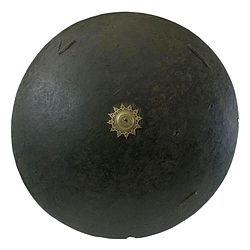Peurise
| Peurise | |
|---|---|

|
|
| Information | |
| Weapon type: | sign |
| Designations: | Peurise, (see text) |
| Use: | weapon |
| Region of origin / author: |
Indonesia , ethnic groups from Indonesia |
| Distribution: | Indonesia |
| Overall length: | about 25 cm to about 48 cm / diameter |
| Lists on the subject | |
The Peurise even Ampang Ampang , Parise , Parinse , Perisei , Perise , Perrisse , pricei or pinch called, is a sign of the Indonesian island of Sumatra .
description
The Peurise Awe is a round shield that is available in countless versions. On the inside there are several rings through which a rope or fabric straps are pulled. An arm is put through these straps and the hand grips part of the fabric straps or rope. With the Gayo and Alas , a rattan ring is pulled through the eyelets instead of fabrics or a rope to serve as an arm ring. The handle in this case is made of wood ( Indonesian Amat Amaton ). The inside is usually padded with fabric to reduce the impact of a weapon on the shield. The wooden versions of the peurise in Gayo are larger than those in Aceh . These shields from Aceh are usually covered with buffalo skin or tiger skin, and studded with semicircular, star-shaped decorated brass buttons . They often have a smooth or pressed outer edge (indonian Sikureueng Dek or Limong Dek). The shields are available with different numbers of these brass buttons. There are versions with four, five, six, seven or nine of these buttons. On the rattan versions of these shields ( Peurise Awe ) there are mostly larger brass decorations that are wider or also worked á jour . Ornaments made of metal in the shape of a triangle ( Indonesian Tumpals ), stars and groups of stars like those of the Pleiades ( Indonesian Tuju Bintang ) and the crescent moon are also common. On the march , the peurise is carried on the back.
Web links
Individual evidence
- ^ Albert G. van Zonneveld: Traditional weapons of the Indonesian archipelago. C. Zwartenkot Art Books, Leiden 2001, ISBN 90-5450-004-2 , p. 106.
